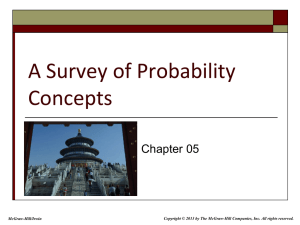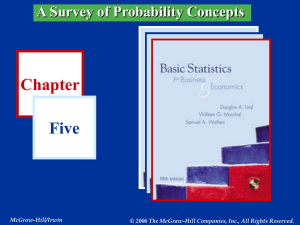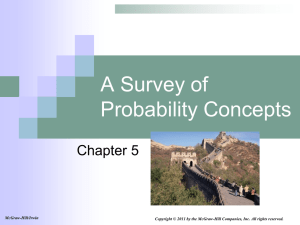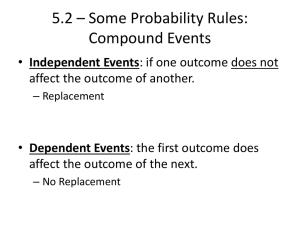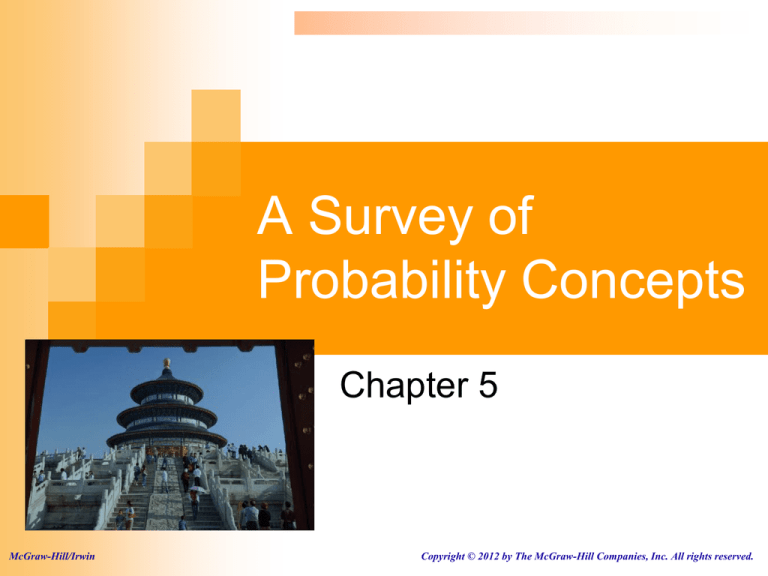
A Survey of
Probability Concepts
Chapter 5
McGraw-Hill/Irwin
Copyright © 2012 by The McGraw-Hill Companies, Inc. All rights reserved.
Learning Objectives
LO1
LO2
LO3
Define probability.
Explain the terms experiment, event, outcome,
Identify and apply the appropriate approach to
assigning probabilities,
LO4 Calculate probabilities using the rules of addition,
LO5 Define the term joint probability,
LO6 Calculate probabilities using the rules of
multiplication,
LO7 Define the term conditional probability,
LO8 Calculate probabilities using a contingency table,
LO9 Calculate a probability using Bayes’ theorem,
LO10 Determine the number of outcomes using the
appropriate principle of counting.
5-2
LO2 Explain the terms
experiment, event, outcome
Probability, Experiment, Outcome, Event: Defined
PROBABILITY A value between
zero and one, inclusive, describing
the relative possibility (chance or
likelihood) an event will occur.
An experiment is a process
that leads to the occurrence
of one and only one of several
possible observations.
An outcome is the particular
result of an experiment.
An event is the collection of
one or more outcomes of an
experiment.
5-3
LO3 Identify and apply the appropriate
approach to assigning probabilities
Mutually Exclusive Events and
Collectively Exhaustive Events
Events are mutually exclusive if the occurrence of any one event means
that none of the others can occur at the same time.
Events are collectively exhaustive if at least one of the events must occur
when an experiment is conducted.
The sum of all collectively exhaustive and mutually exclusive events is 1.0 (or
100%)
collectively
exhaustive and
mutually exclusive
events
Events are independent if the occurrence of one event does not affect the
occurrence of another.
5-4
LO3
Classical and Empirical Probability
Consider an experiment of rolling a sixsided die. What is the probability of the
event “an even number of spots appear
face up”?
The possible outcomes are:
The empirical approach to probability is based on what
is called the law of large numbers. The key to
establishing probabilities empirically is that more
observations will provide a more accurate estimate of
the probability.
EXAMPLE:
On February 1, 2003, the Space Shuttle Columbia
exploded. This was the second disaster in 123
space missions for NASA. On the basis of this
information, what is the probability that a future
mission is successfully completed?
There are three “favorable” outcomes (a
two, a four, and a six) in the collection of
six equally likely possible outcomes.
Number of successful flights
Total number of flights
121
0.98
123
Probabilit y of a successful flight
5-5
LO3
Subjective Probability - Example
If there is little or no past experience or information on which to
base a probability, it may be arrived at subjectively.
Illustrations of subjective probability are:
1. Estimating the likelihood the New England Patriots will play in the
Super Bowl next year.
2. Estimating the likelihood you will be married before the age of 30.
3. Estimating the likelihood the U.S. budget deficit will be reduced by
half in the next 10 years.
5-6
LO3
Summary of Types of
Probability
5-7
LO4 Calculate probabilities using rules
of addition.
Rules of Addition
Rules of Addition
Special Rule of Addition - If two events
A and B are mutually exclusive, the
probability of one or the other event’s
occurring equals the sum of their
probabilities.
P(A or B) = P(A) + P(B)
EXAMPLE:
An automatic Shaw machine fills plastic bags with a mixture
of beans, broccoli, and other vegetables. Most of the bags
contain the correct weight, but because of the variation in
the size of the beans and other vegetables, a package might
be underweight or overweight. A check of 4,000 packages
filled in the past month revealed:
The General Rule of Addition - If A
and B are two events that are not
mutually exclusive, then P(A or B) is
given by the following formula:
P(A or B) = P(A) + P(B) - P(A and B)
What is the probability that a particular package will be
either underweight or overweight?
P(A or C) = P(A) + P(C) = .025 + .075 = .10
5-8
LO4
The Complement Rule
The complement rule is used to
determine the probability of an event
occurring by subtracting the
probability of the event not occurring
from 1.
P(A) + P(~A) = 1
or P(A) = 1 - P(~A).
EXAMPLE
An automatic Shaw machine fills plastic bags with a
mixture of beans, broccoli, and other vegetables. Most of
the bags contain the correct weight, but because of the
variation in the size of the beans and other vegetables, a
package might be underweight or overweight. Use the
complement rule to show the probability of a satisfactory
bag is .900
P(B) = 1 - P(~B)
= 1 – P(A or C)
= 1 – [P(A) + P(C)]
= 1 – [.025 + .075]
= 1 - .10
= .90
5-9
LO5 Define the term joint probability.
LO4
The General Rule of Addition and Joint Probability
The Venn Diagram shows the result of a
survey of 200 tourists who visited Florida
during the year. The survey revealed that 120
went to Disney World, 100 went to Busch
Gardens and 60 visited both.
JOINT PROBABILITY A probability that measures
the likelihood two or more events will happen
concurrently.
What is the probability a selected person
visited either Disney World or Busch
Gardens?
P(Disney or Busch) = P(Disney) + P(Busch) - P(both Disney and Busch)
= 120/200 + 100/200 – 60/200
= .60 + .50 – .80
5-10
LO6 Calculate probabilities using the
rules of multiplication.
Special and General Rules of Multiplication
The special rule of multiplication requires that two events A and B are independent.
Two events A and B are independent if the occurrence of one has no effect on the probability of
the occurrence of the other.
This rule is written: P(A and B) = P(A)P(B)
EXAMPLE
A survey by the American Automobile association (AAA) revealed 60 percent of its
members made airline reservations last year. Two members are selected at random. Since
the number of AAA members is very large, we can assume that R1 and R2 are
independent. What is the probability both made airline reservations last year?
Solution:
The probability the first member made an airline reservation last year is .60, written as P(R1) = .60
The probability that the second member selected made a reservation is also .60, so P(R2) = .60.
Since the number of AAA members is very large, you may assume that R1 and R2 are independent.
P(R1 and R2) = P(R1)P(R2) = (.60)(.60) = .36
5-11
LO6
Special and General Rules of Multiplication
The general rule of multiplication is used to find the joint probability that two independent
events will occur.
EXAMPLE
A golfer has 12 golf shirts in his closet. Suppose 9 of these shirts are white and the others blue.
He gets dressed in the dark, so he just grabs a shirt and puts it on. He plays golf two days in a
row and does not do laundry.
What is the likelihood both shirts selected are white?
The event that the first shirt selected is white is W1. The probability is P(W1) = 9/12
The event that the second shirt (W2 )selected is also white. The conditional probability that the
second shirt selected is white, given that the first shirt selected is also white, is
P(W2 | W1) = 8/11.
To determine the probability of 2 white shirts being selected we use formula: P(AB) = P(A) P(B|A)
P(W1 and W2) = P(W1)P(W2 |W1) = (9/12)(8/11) = 0.55
5-12
LO8 Calculate probabilities using a
contingency table.
Contingency Tables
A CONTINGENCY TABLE is a table used to classify sample observations according to two or more identifiable
characteristic
EXAMPLE:
E.g. A survey of 150 adults classified
each as to gender and the number of
movies attended last month. Each
respondent is classified according to
two criteria—the number of movies
attended and gender.
Event A1 happens if a randomly selected
executive will remain with the company
despite an equal or slightly better offer
from another company. Since there are
120 executives out of the 200 in the
survey who would remain with the
company
P(A1) = 120/200, or .60.
Event B4 happens if a randomly selected
executive has more than 10 years of
service with the company. Thus, P(B4| A1)
is the conditional probability that an
executive with more than 10 years of
service would remain with the company.
Of the 120 executives who would remain
75 have more than 10 years of service, so
P(B4| A1) = 75/120.
5-13
LO8
Tree Diagrams
A tree diagram is useful for portraying
conditional and joint probabilities. It is
particularly useful for analyzing business
decisions involving several stages.
A tree diagram is a graph that is helpful
in organizing calculations that involve
several stages. Each segment in the tree
is one stage of the problem. The branches
of a tree diagram are weighted by
probabilities.
5-14
LO10 Determine the number of outcomes
using the appropriate principle of counting.
Permutation and Combination
A permutation is any arrangement of
r objects selected from n possible
objects. The order of arrangement is
important in permutations.
EXAMPLE
Suppose that in addition to selecting
the group, he must also rank each of
the players in that starting lineup
according to their ability.
12 P 5
12!
95,040
(12 5)!
A combination is the number of ways to
choose r objects from a group of n objects
without regard to order.
EXAMPLE
There are 12 players on the Carolina Forest
High School basketball team. Coach
Thompson must pick five players among the
twelve on the team to comprise the starting
lineup. How many different groups are
possible?
12 C5
12!
792
5!(12 5)!
5-15

